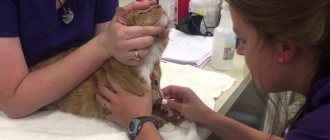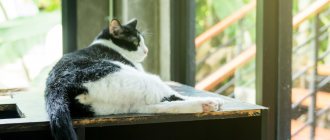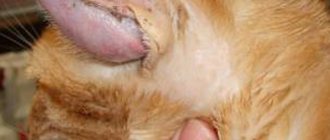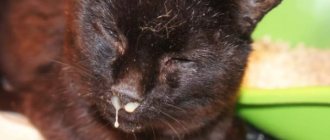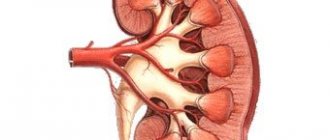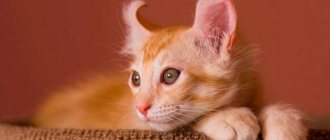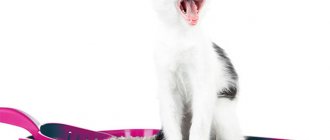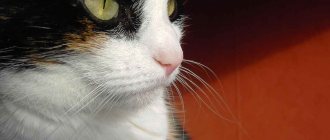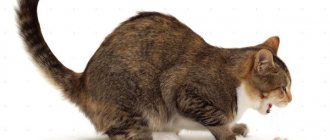8170Administration
3
Urinary incontinence in a cat, which owners often perceive as hooliganism on the part of the animal, is actually a sign of a health problem in a furry or hairless pet. To eliminate this unpleasant phenomenon, the cat must receive high-quality medical care, for which it should be shown to a veterinarian. If this is not done, the disease that caused the incontinence will continue to progress and may lead to the death of the sick cat. Provided that therapy begins in a timely manner, the likelihood that the problem will be eliminated completely is very high.
Causes of the disease
Uncontrolled urination in a cat is not an independent disease, but a symptom of a pathology of a neurogenic nature, structural anomalies of the urinary system, functional disorders or psycho-emotional stress.
The main reasons why a cat began to urinate not in the tray, but in the wrong places, include the following:
- Infections in any part of the urinary system.
- Congenital anomalies of the genitourinary system.
- ICD (urolithiasis). Constant irritation of the sphincter leads to the fact that urine is not retained in the ureters and bladder.
- Metabolic disorders associated with diabetes, obesity. Urine is usually excreted in droplets.
- Damage to the brain or spinal cord due to trauma, hypertension, inflammatory processes.
- Old age of the pet. In old age, all body systems can no longer cope with their functions, muscles weaken, which leads to urine leakage.
- Frequent childbirth. A cat that gives birth more than once a year does not have time to recover its urinary system, which disrupts the normal functioning of the bladder. This leads to persistent incontinence.
- Spasm of the bladder muscles. Urine is excreted once.
- Paralysis of the lower body and limbs. The cat urinates constantly.
- Injuries and damage to the bladder. Various degrees of urination.
- Oncology and benign tumors in the bladder and urethra.
- Surgical intervention (including castration), during which the nerve endings were damaged.
Sometimes the problem of uncontrolled urine output can be encountered after a cat has had a catheter inserted. This phenomenon goes away after a few days on its own without treatment.
Finally, the cause of uncontrolled urine output is often the stress that the cat has experienced - a change of place of residence, a large number of guests in the house, the appearance of another pet, etc.
What to do if your cat has urinary incontinence?
Sometimes urinary incontinence occurs as a postpartum complication. The pathology resolves spontaneously. In all other situations, if incontinence is suspected, the cat is sent to the clinic for examination.
The veterinarian conducts an examination, takes blood for analysis, performs an ultrasound, makes a diagnosis and prescribes treatment. If surgery is indicated, it is performed in a clinic, and postoperative care is provided by the animal owner at home. If conservative treatment is required, follow the procedures prescribed by the veterinarian.
With urolithiasis, situations arise when it is necessary to insert a catheter to drain urine. If your cat is diagnosed with diabetes, you will need insulin therapy and a special diet that is low in carbohydrates and high in protein and fat.
Symptoms
It is impossible not to notice urinary incontinence in a pet. Wet spots remain in those places where the cat has just stood or sat, and she always has wet fur on the inner thighs, under the tail.
In addition, the animal’s behavior changes. Cats are naturally very clean animals, trained to use a litter tray from an early age. With involuntary urine discharge, embarrassment can happen at any time - during sleep or wakefulness, when the cat simply does not have time to run to its toilet.
Realizing that she made a puddle in the wrong place, the poor guy looks scared and restless. And if the owners begin to swear, express indignation at the offense, and even more so resort to punitive measures, then this becomes very stressful for the animal.
Based on the degree of urine output, several forms of incontinence are distinguished:
- Undermining. Urine is released involuntarily in a small volume, dropwise, after physical exertion. The general condition of the cat is unsatisfactory, even if he has undergone appropriate treatment.
- Constant selection. Urine leaks every time after any movement or change in the position of the cat’s body. The back and stomach are constantly wet. The litter where he rests is thoroughly saturated with urine. The animal smells bad and, experiencing severe discomfort, constantly licks itself.
- Urgentnaya. The cat does not feel the urge to urinate. Because of this, the bladder becomes full and urine leaks randomly. This worries the pet, who does not understand what is happening to him. He needs to be reassured, but under no circumstances should he be scolded.
- Stressful. Urine flows out in different volumes - from a few drops to copious discharge.
Regardless of how often and in what volume the cat excretes urine, you should immediately take your pet to a veterinary clinic, where he will be examined by a veterinarian.
Preventing urinary incontinence in cats
Preventing pathology involves following the rules for keeping and feeding a cat. There should be no drafts in the room. The cat should not be bathed frequently, and if such a need arises, it should be thoroughly dried and allowed to dry before being released indoors.
It is necessary to decide on feeding - natural or ready-made food. You cannot alternately feed both. If you decide to change the type of feeding, this should be done gradually, over the course of a week.
The use of economy-class feeds unbalanced in amino acids and vitamins accelerates the development of chronic diseases that lead to inflammatory processes in the genitourinary area and urinary incontinence. Therefore, it is necessary to use ready-made food of at least premium class. The use of canned food and granules can be alternated.
Neutered animals should be fed prepared food for sterilized cats. Excess gonads alter metabolic processes and increase susceptibility to the formation of urinary stones. Sterilization at an early age causes the urinary ducts to stop growing and they remain narrow.
If urate salt precipitates, a grain of sand is formed. In animals with a normal width of the ureter, it skips. With a narrowed lumen, the stone gets stuck. An obstruction to the outflow of urine is formed. Urolithiasis (urolithiasis) develops.
Be sure to read:
A cat is vomiting hair: reasons, what to do, medications and folk remedies, prevention
Additional diagnostics will be required to prescribe treatment. If struvite stones have formed, urine acidifying foods will be required. When oxalate stones are detected, the urine must be alkalized by selecting feed. Cats are transferred to specially developed medicinal food.
For pets predisposed to KSD, it is recommended to use bottled still water for drinking. Treats from the table must be stopped. Products that are unusual for cats contain substances that provoke the development of chronic diseases.
Obese cats are transferred to ready-made dietary food. If you limit the consumption of natural food, your pet will feel hungry and scream, begging for food. Diets for overweight animals contain a high percentage of dietary fiber, which limits consumption. The pet's body will receive fewer calories, but the animal will feel full.
Medicinal food has been developed for cats suffering from kidney disease, diabetes, and urolithiasis. However, a cat cannot be protected from one disease. This is old age. Older pets are switched to specialized food that allows them to feel satisfactory.
Diagnostics in a veterinary clinic
To make a diagnosis, the veterinarian, in addition to a visual examination of the animal and anamnesis, conducts a number of diagnostic studies. These include urine analysis, blood biochemistry, pelvic x-ray, and urological ultrasound. Sometimes additional diagnostic methods are used.
Urine for analysis must be collected correctly, otherwise feces caught in the urine may affect the results of the study.
It is advisable that the material for analysis be taken directly by a specialist.
Methods for treating a cat
Treatment is selected after determining the cause of incontinence:
- if inflammation is present, the veterinarian prescribes a course of antibiotics, taking into account the individual characteristics of the pet’s body;
- if the reason lies in excess weight, you should choose a balanced diet for your pet and monitor its activity;
- in case of detection of disorders in the functioning of the nervous system, the veterinarian initially determines what is causing the occurrence of such a condition.
Involuntary urination due to stress, childbirth or sterilization most often goes away with time, without the use of medications. However, in this case, it is important to provide proper care to your pet.
It is forbidden to treat an animal with drugs intended to relieve incontinence in humans - this will significantly worsen the general condition of the pet.
There are types of abnormalities that cannot be corrected with treatment - most often they are characteristic of older representatives of the cat family. In this case, the cat is put on a diaper and trays are placed in all rooms. Without the advice of a specialist, you should not select medications for your animal on your own - this can lead to complications.
Treatment method and prognosis
In case of involuntary urine discharge, complex treatment is carried out. The scheme is drawn up individually, depending on the cause of the pathology, age, and condition of the animal.
The main treatment methods include:
- Antibiotic therapy. Relevant for identifying infections and bacteria in the genitourinary system. The drug is administered intramuscularly or intravenously.
- The use of medications to normalize metabolic processes in the body.
- Special diet (if the pet is overweight).
- Antispasmodics and painkillers (for urolithiasis).
- Drugs that strengthen the tone of the bladder walls and stimulate the activity of the sphincter.
The prognosis depends on the disease. So, if incontinence is associated with an infection in the body, then after appropriate treatment it goes away.
Unfortunately, in some cases it is no longer possible to get rid of this unpleasant disease. If the cat is old, then its weakened body cannot adequately respond to therapeutic measures. In addition, the tissues are not restored and rejuvenated, so urine will leak constantly and its volume will increase.
The only thing that remains for the owner to do is to come to terms with it and provide the pet with the most comfortable living conditions. You can place trays in different places in the apartment or put a diaper on the cat.
Preventive measures
In order to prevent the occurrence of enuresis in a pet, it is important to exclude all factors and causes that have a positive effect on the development of this pathology. It is important to feed your cat properly and prevent injuries, falls and bruises. There should be no drafts or excessively low temperatures in the room where the cat is located.
Systematic examinations by a veterinarian for preventive purposes are the best way to prevent urinary incontinence and any other disease in a pet.
What to do at home
Self-medication is dangerous to health! Using medications, especially human medications, without consulting a specialist can worsen the situation!
You need to understand that involuntary urine leakage is not mischief or stubbornness at all, it is a disease from which the pet suffers. Follow all the veterinarian's instructions and provide your pet with good care and adequate feeding.
And, of course, surround your four-legged pet with love and care so that he feels safe.
Prevention
Preventive measures come down to preventing provoking factors. These include:
- Systematic examinations by a veterinarian so that the disease can be detected at an early stage.
- Providing comfortable conditions for the cat: suitable temperature conditions, absence of drafts, safe space so that the pet cannot get injured.
- Balanced nutrition, mainly premium food. Mixing natural products and industrial feeds is unacceptable.
- Vitamin and mineral complexes (after consultation with a veterinarian).
- Exclusion from the diet of economy-class feed (Whiskas, Friskas, etc.).
- Using bottled water.
Old age is an irreversible phenomenon, and no matter how much you take care of your cat, who has already become a member of the family, he cannot avoid it. It is in old age that a four-legged pet needs affection and care.
Informed in such a delicate issue as urinary incontinence in cats, the causes and treatment of enuresis, owners treat their pets more carefully, because, as we know, the disease is easier to prevent than to treat.
Methods for diagnosing cystitis
Among the methods for diagnosing the disease:
- Analysis of urine. During the inflammatory process, the number of leukocytes in urine increases, and protein and bacteria are also detected. If salt crystals are found in the urine, this indicates the presence of urolithiasis. Additionally, red blood cells may be present in urine.
- Blood analysis. This research method is considered auxiliary, since with cystitis the indicators may be within normal limits. Only occasionally, during acute inflammation, the level of leukocytes in the blood increases.
- Ultrasound. This method of research is considered the most reliable of all listed, as it helps to identify not only the inflammatory process in the bladder, but also stones. With cystitis, the walls of the organ thicken, which can be seen on a computer monitor.
Abdominal ultrasound can detect cystitis and urolithiasis
During the initial examination of the pet, the doctor may suspect cystitis based on the presence of characteristic signs: frequent urination, scanty urine output and abdominal pain.
Forms of incontinence
In cats, urinary incontinence can take various forms. They are classified according to the degree of urine leakage.
The classification of the disease is as follows:
- dripping - with this phenomenon, urine leaks from the pet in a small amount. It is released involuntarily in the form of drops and most often if the cat has experienced significant physical exertion. Constant dripping of urine is not common, but in this case the general condition of the animal, as a rule, suffers greatly. Even if a cat who suffered from incontinence has undergone the necessary treatment, its condition remains unsatisfactory;
- constant flow of urine - this phenomenon is diagnosed if the cat produces urine every time it changes body position or makes any movements. The back of the cat's body is constantly wet, and his bed is saturated with urine, and he emits an extremely unpleasant, pungent odor. The cat, as a rule, is very worried about this phenomenon, tries not to rub itself on the owner’s clothes and constantly washes itself;
- Urgenic form - with this disorder, the cat often does not feel the urge to urinate, which is why, when the bladder is full, urine flows out sharply, which greatly frightens the animal. The pet is immediately lost and cannot quickly understand what happened to it. The owner should under no circumstances scold his pet. He must be immediately reassured and consoled.
- stress form - incontinence occurs due to the fact that the cat is experiencing severe stress or fear. At the same time, urine is released sharply and in varying volumes - from small to copious;
- Sometimes a cat may experience urinary incontinence after catheterization. There is no need to treat the cat; the consequences of installing a catheter go away on their own within a few days.
Depending on what form of pathology occurs in the animal, it is determined what kind of therapy will be carried out in a particular case. All treatment is prescribed by a veterinarian, and a visit to him should not be postponed if a problem is detected. When urinary incontinence occurs in a neutered cat, treatment can be especially difficult.
